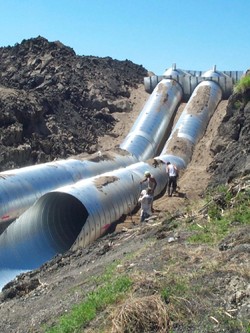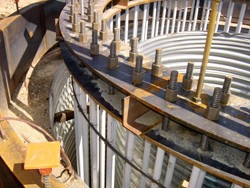Erosion Prevention
 Soil erosion by water is a common and destructive force that plagues many project sites. It makes unsightly gullies on roadways, cut slopes and embankments. It gouges out side ditches, fills culverts with sediment and is a costly nuisance.
Soil erosion by water is a common and destructive force that plagues many project sites. It makes unsightly gullies on roadways, cut slopes and embankments. It gouges out side ditches, fills culverts with sediment and is a costly nuisance.
There are three basic ways of preventing erosion. The first is to treat the surface by paving, riprapping or using erosion-resistant turn, vines or other vegetation. Second, the velocity of the water may be reduced by means of ditch checks. The third method is to intercept the water through inlets and convey it in corrugated steel flumes, pipe spillways, stream enclosures or storm drains. Larger streams may be controlled by steel sheeting, jetties or retaining walls.
CSP, with its long lengths, positive joints and flexibility to conform to shifting soil, provides a most dependable means of solving erosion problems.
Dams and Levees
Earth dams, levees and many other types of embankments require culverts or outlets for intercepted or impounded water. Corrugated steel pipes are particularly advantageous and have enviable records for this type of service.
Dams and levees impound water and ultimately need pipe for drains and relief structures. Soil conditions at these locations are seldom ideal,, therefore strong, flexible pipes are needed to resist disjointing, settlement and infiltration of the surrounding soil. CSP meets the demanding durability and structural needs for dams and levees. A local or regional office of the Natural Resources Conversation Service (NRCS) can be helpful in suggesting suitable details, such as diaphragms, anti-vortex baffles and riser sections based on proven local practice.
Power Plant Cooling Water Lines
Power plants require vast amounts of cooling water. Structural plate steel pipes over 18 feet in diameter have been used for water intake and outlet. These lines are typically subaqueous, requiring special underwater construction by divers. Corrugated steel is especially suitable for this type of construction and has been used for such lines in the Great Lakes region.

Non-Drainage Applications
Steel conduits serve many practical purposes other than drainage. Some examples include:
- Underpasses and Overpasses for Pedestrians and Animals
- Vehicular and Rail Grade Separations
- Conveyors, Tunnels and Granaries
- Utility Conduits
- Bent Protection Systems
- Containment Rings and Tanks
- Agricultural Ventilation Systems
- Foundation Structures
- Aerial Conduits
- Service Tunnels
- Architectural Design (such as supports and free-standing columns)
- Ventilation and Fan Ducts
For more information on non-drainage applications, check out the Corrugated Steel Pipe Design Manual